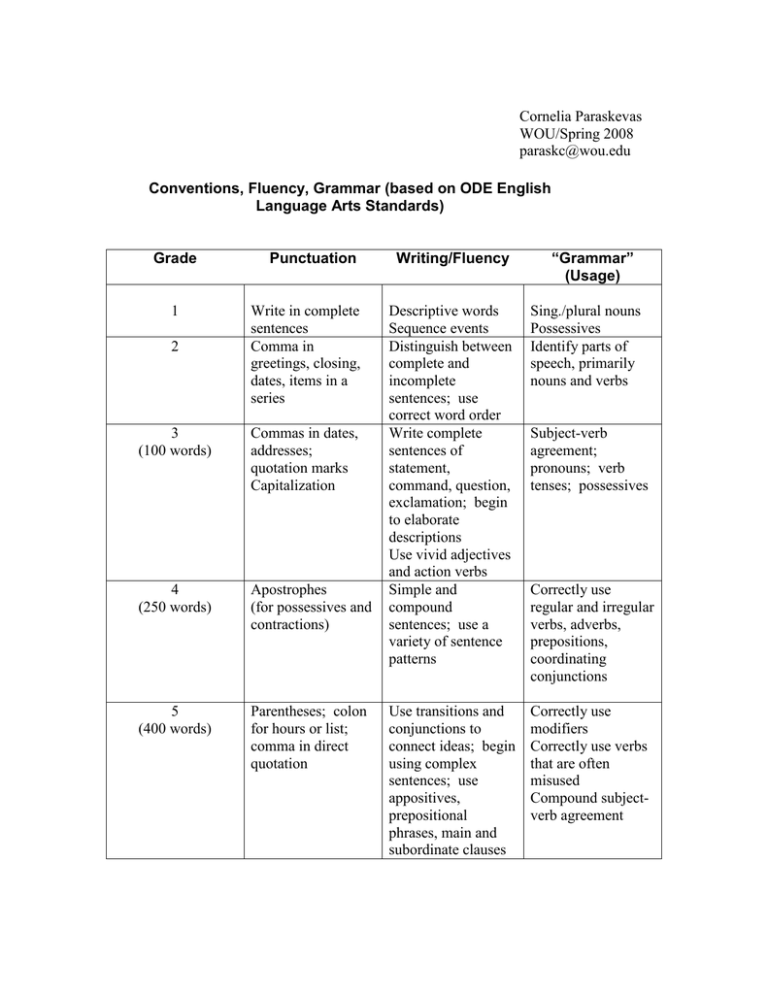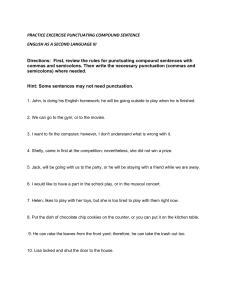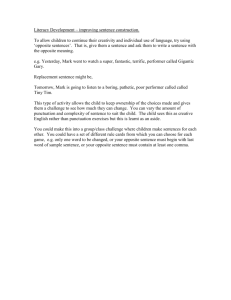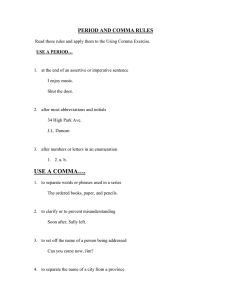Document 16112312
advertisement

Cornelia Paraskevas WOU/Spring 2008 paraskc@wou.edu Conventions, Fluency, Grammar (based on ODE English Language Arts Standards) Grade 1 2 “Grammar” (Usage) Punctuation Writing/Fluency Write in complete sentences Comma in greetings, closing, dates, items in a series Descriptive words Sequence events Distinguish between complete and incomplete sentences; use correct word order Write complete sentences of statement, command, question, exclamation; begin to elaborate descriptions Use vivid adjectives and action verbs Simple and compound sentences; use a variety of sentence patterns Sing./plural nouns Possessives Identify parts of speech, primarily nouns and verbs Use transitions and conjunctions to connect ideas; begin using complex sentences; use appositives, prepositional phrases, main and subordinate clauses Correctly use modifiers Correctly use verbs that are often misused Compound subjectverb agreement 3 (100 words) Commas in dates, addresses; quotation marks Capitalization 4 (250 words) Apostrophes (for possessives and contractions) 5 (400 words) Parentheses; colon for hours or list; comma in direct quotation Subject-verb agreement; pronouns; verb tenses; possessives Correctly use regular and irregular verbs, adverbs, prepositions, coordinating conjunctions 6 (400-700 words) Colon after salutation; semicolon to connect main clauses; comma with coordinating conjunction; comma and semicolon for transitions 7 (400-700 words) Comma after dependent clause; appropriate internal punctuation including commas, semicolons, colons 8 (500-1,000 words) Use conventional punctuation correctly, including commas, hyphens, dashes, semicolons CIM Use conventional punctuation correctly, including semicolons, colons, ellipses, hyphens, dashes Use variety of descriptive words. Use compound, complex, simple sentences to achieve clarity and enhance flow and rhythm. Use effective coordination and subordination of ideas To achieve clarity, properly place modifiers. Vary sentence beginnings by using infinitives/participles Indefinite pronouns; compound subjectverb agreement Perfect tenses Parallel structures. Use varied sentence types and sentence openings to present lively and effective personal style. Use subordination, coordination, appositives Demonstrate an understanding of sentence construction to achieve clarity of meaning. Vary sentence types to enhance flow and rhythm Use consistent verb tenses. Consistently use frequently misused words (between/among; less/fewer) Clear pronounantecendent reference; correct use of all parts of speech (N, V, Pro, Adj, Adv, Prep, Conj, Interj; correct use of types and structures of sentences. Appropriate English usage Show control of clauses (main and subordinate) and phrases (gerund, infinitive, participle)


